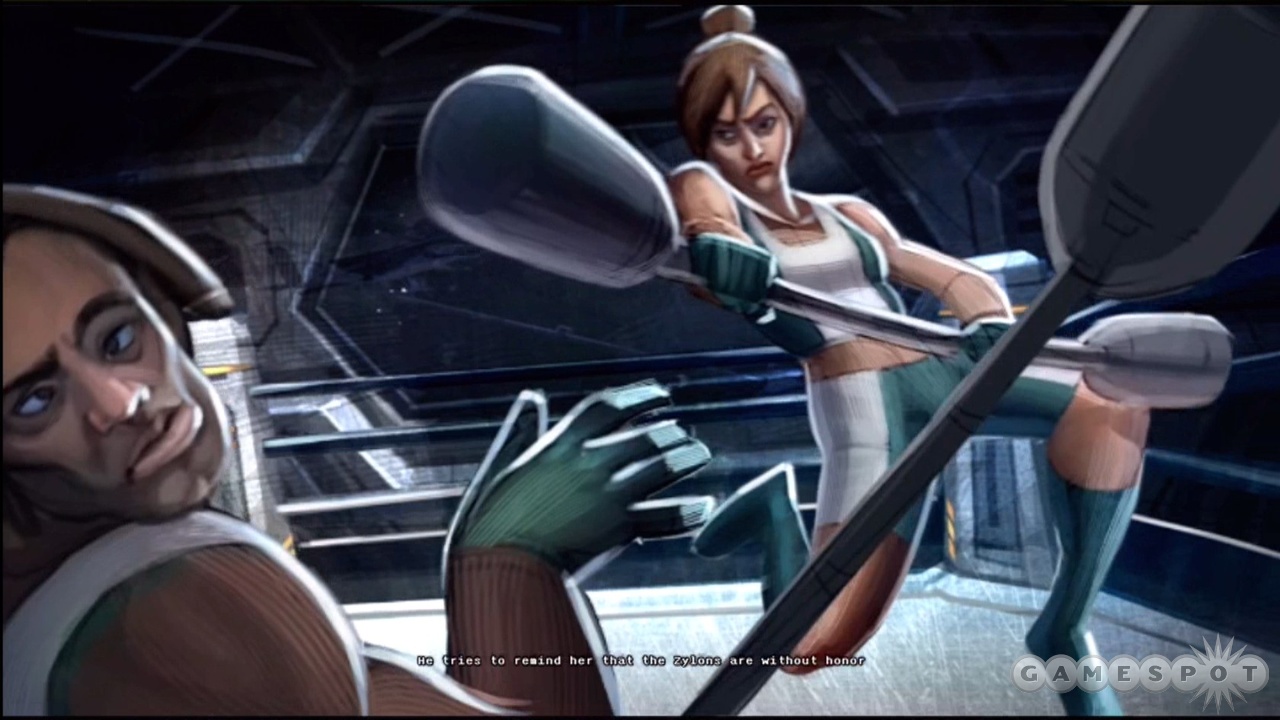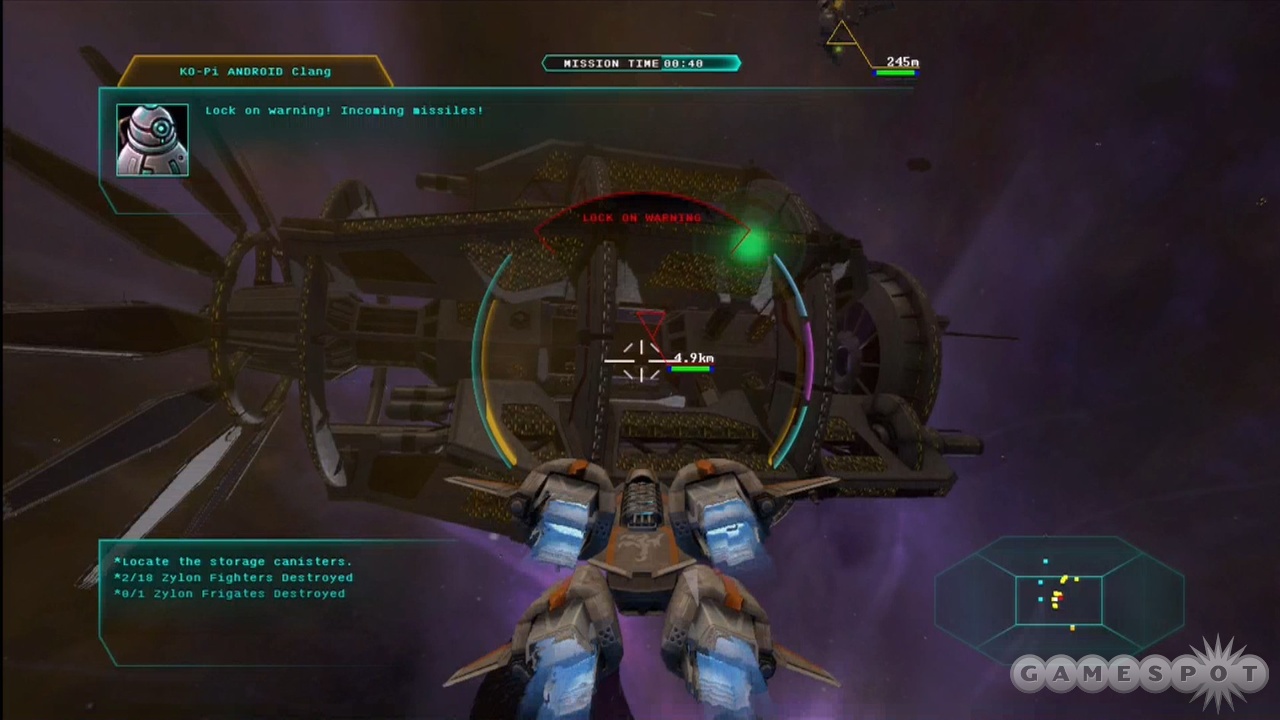The original 1979 Star Raiders was a complex and ambitious space combat game that involved navigating across the galaxy via hyperspace, scanning for hostiles, and managing damage to weapons, engines, and other ship components. It also had a sense of humor; at the end of a game, heroic players might earn the rank of Star Commander, while less successful pilots might be designated Galactic Cooks. Now, following in the footsteps of last month's Yar's Revenge, which also took the title of an Atari classic, is a new game called Star Raiders. But it possesses none of the ambition or fun of its namesake. On the contrary, Star Raiders is an awful space combat game, with nothing to offer to newcomers and only anguish in store for those with fond memories of the original.
As a crackerjack pilot in the Atar Academy, you're called upon to help defend humanity from the mysterious Zylons. (This isn't a reference to the Cylons of the recent Battlestar Galactica series. It's a reference to the original game's Zylons, who were themselves a reference to the Cylons of the original Battlestar Galactica series.) The story initially attempts to drum up a sense of camaraderie between your character, Ruiz, and his friends at the academy, but there's too little time spent on this for it to amount to anything, and the monotonous narrator imbues the tale with all the excitement of a legal document. The illustrations that tell the story look as if they were done quickly, and the attempts to bring a sense of movement to these drawings sometimes have unintentionally hilarious results. On the plus side, abbreviation enthusiasts will appreciate that the game has plenty of lines like, "It is the only ship capable of delivering the Mass Ordinance Plasma Bomb, or MOPB, which can destroy the SMCD."
Once you climb into the cockpit, the real problems begin. Star Raiders has a sorry excuse for a tutorial. Your ship can transform into three configurations: the slow but powerful turret mode, the balanced assault mode, and the speedy but vulnerable attack mode. The tutorial missions give you paragraphs of text to absorb about the best uses for each of these three modes, but this information isn't actively reinforced by the very basic tasks that follow. As a result, once you find yourself in real combat situations, it's tough to get a handle on when to switch from one form to the next, and on the different control schemes for different forms. (By default, the right stick controls pitch and yaw while in assault and turret modes, but in attack mode, the left stick controls pitch and roll.) The tutorials also offer no advice on how to evade locked-on enemy torpedoes or how to most effectively use the EMP and countermeasures your ship is equipped with. As for making sense of the gauges that surround your targeting reticle, you're shown a labeled diagram before tutorial missions, and that's it. Concepts like managing energy consumption would be far easier to grasp if the game took a moment to touch on these as you were playing, rather than expecting you to fully understand them just by reading about them once.

Sadly, putting in the time to get familiar with the game just isn't worth it. The Zylons may have fighters, frigates, and cruisers, but their most powerful weapon is boredom. Battling Zylon fighters has none of the cat-and-mouse thrills that good dogfighting should have; you can usually get them in your sights from a distance and take them out easily, making their feeble attempts to be elusive a frustrating postponement of the inevitable rather than a source of excitement. Far worse than dealing with these tiny fighters is the incredibly tedious process of taking down Zylon capital ships. Zylon cruisers and frigates have several small generators on their hulls that must be destroyed to take out the ships, and the most effective way to do that is to transform into assault mode and slowly move along the ship's surface from one generator to the next, pumping bullets into them until they explode.
It's an excruciatingly dull process, and after doing it for the umpteenth time, seeing that the next mission requires you to destroy still more frigates and cruisers may be enough to make you throw up your arms in surrender and let the Zylons win. Late in the game, when you finally get to take on one of the massive Zylon basestar vessels, it's almost comically disappointing that destroying one of these monstrosities boils down to flying inside it and taking out still more of those stupid little generators. And there's no sense of danger in any of this; when you die, you simply respawn a few seconds later, good as new.
If you choose to persevere through all of this crushing boredom and repetition, you're rewarded with a climactic mission in which you must fly through ventilation shafts into a Zylon structure deep beneath the surface of a planet. It's at least different from anything that comes before, but it culminates in a sequence in which you must escape from the structure before it gets blown to kingdom come. Infuriatingly, failing to do so sets you back to the start of the entire mission, forcing you to repeat a great deal of tedious gameplay before you can attempt the escape again.

The drab interstellar battlefields of Star Raiders are a fitting accompaniment to the dull gameplay, and the constant blaring of the alarm warning you of an enemy lock-on is a maddening incentive to turn the game off and do something else. It's a shame that there are now so few good games being made in the once-flourishing space combat genre, but no matter how desperate you are for some interstellar action, there's no reason to play Star Raiders. On the original game's rating scale, this game earns the particularly shameful rank of Garbage Scow Captain.



